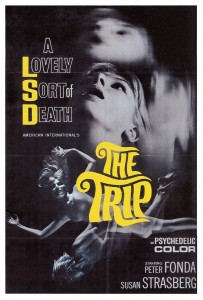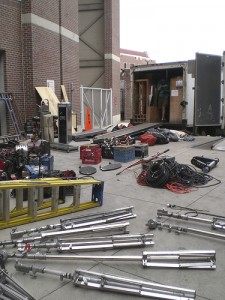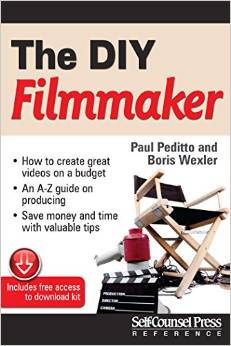***HEY ALL! Just back from a month of faraway Eastern landscapes where I confronted Real Feel temperatures of 107 and consulted the Gods for wisdom on future projects. I also dipped my feet into an aquarium filled with feet-chewing fish that felt like a hundred electric razors buzzing. The Gods instructed me to humble myself this year, so here’s what that fish thing looked like…
So, back to business…let’s talk micro-budget…
In an earlier post we talked about preparation and outlining for writing a Micro-Budget screenplay. Today we’ll talk about writing the script itself. This Top 10 list (split in two, 5 today, 5 next week) is NOT gospel– it’s a set of guidelines, not a be-all-and-end-all. These “rules” helped keep the budget for our feature Chat to 44K. You can find Chat on VUDU here, iTunes here, or elsewhere. More on the making of Chat and D.I.Y Filmmaking can be found here.
So, if you’re working on a script you want to shoot cheap, this list might help. Let’s get going…
First, before you write Fade In, you need to get your head in the right place. That means having energy. This is a process choice—how many times a week do you write? What time of day? How many hours each session? You say writing this is a priority but you’ve got to prove it by carving out time. The time of day you pick isn’t the key—it’s the energy you bring to the project.
Some folks write one hour a day, seven days a week. Some write four hours a pop two or three times a week. Some are weekend warriors, not even touching the script during the week. Some can close a door and steal valuable energy at work. When you write is as critical as what you write. You have to bring A-Energy. How you do that depends on your job and family situations. Sometimes you’re feeling blocked might just be a case of poor energy. And there’s something else you need to do…
Kill the perfectionist instinct. There are going to be major rewrites, minor rewrites, polishes, trims, tucks… your script, in constant revision mode. The script is never done. Even with micro-budget you’ll be debating into the editing process everything from single lines up to full scenes that might not make the final cut. You’ll be changing the supposedly “locked” shooting script while on set. Not to mention the battles you’ll have even making it to the shooting script. Having to write draft after draft after draft…
Depressed yet?
Here’s my point: Don’t keep rewriting the first 30 pages of the first draft because it sucks. Counter-productive. Good writers can lose confidence if they don’t let an unfinished scene go. Relax, you’ll come back to it in the rewrite.
First draft, you push through. Push forward. That’s the purpose of the first “discovery” draft, to say everything you want to say in rough form. If, at the end of Draft 1, you’re looking at 140 pages, so what? You’ll know what needs to be changed on the front end of the script by the time you reach the back end. Don’t censor yourself. Get to the end of the first draft and then refine. Say everything you want to say, no matter how many pages, and don’t try to be perfect. Push it out.
Here are 10 “rules” for Micro-Budget screenplays…
- #1: WRITE WITH A PRODUCER’S MIND
Micro-Budget = money exclusively controlled by you. Could be $500, could be $50,000. It’s not the dollar amount so much as it’s money coming out from your pocket, or your mom’s pocket, or your 1000 Facebook friend’s pockets through a Kickstarter campaign.
If you raised $25,000–you need to write it to shoot for $25,000, period.
That means being aware of the costs of making a movie. What costs money shooting a movie- you need to know. It means looking at the movie as a producer would at story-stage; not forcing your producers into impossible production/post-production decision when the time comes.
- #2: CONCEPT= GENRE + SIMPLICITY + VISION
The grand-daddy of Micro, for me, is Roger Corman. His low-budget B-movies made sure the stories reached the largest number of people by telling stories in a recognizable genre. Certain genres always work for Micro– horror, comedy, thriller, drama.
Corman added campy comedy to his horror, or thriller aspects to a drama. These were “mash-ups” of genre done with simplicity and for a price. The man infused genre pieces with an original vision specific enough to father the “Corman School”, predating the digital D.I.Y. era by 40+ years.
On genres, stay away from period-pieces or post-Apocalyptic action. Anyone who’s seen Primer knows dialogue-heavy sci-fi can be done cheaply. Robert Rodriguez made El Mariachi for the infamous $7,000 bucks so Action is also on the list. Look at Fede Alvarez, who wrote and directed the remake of Evil Dead. How did a young filmmaker from Uruguay get that gig? He made a short film (Panic Attack!) that looked like it was made for a million dollars… for $300! Based on that short film he got noticed and representation in Hollywood. That’s how you play the game! Show the Hollywood gatekeepers you can make a high-quality commercial product dirt cheap.
- #3: WRITE WHAT YOU HAVE= THE ROBERT RODRIGUEZ SCHOOL
Robert Rodriquez literally wrote the book (Rebel Without A Crew) on the subject. Predating the Digital era, his advice on how he made El Mariachi is more relevant today than ever. Locations, props, wardrobe– the goal is to pay for nothing. That means writing into the script nothing you can’t acquire cheaply or for free. While it’s unlikely you can get away with that goal for some costs(DP, Sound, Post House costs), you should fight to hold the line on other costs (actors, locations) Take an accounting of the resources you can bring to the project. Dad owns a bowling alley? Set the script in a bowling alley. Mom runs the local Salvation Army store? The movie’s wardrobe and props will be coming from the Salvation Army. Friend owes you a favor who has a stretch limo? Write it into the script.
- #4:CENTRAL LOCATION= LIMIT COMPANY MOVES
For Chat the director Boris Wexler managed to nail down the Board of Trade offices where he worked, which became our cybersex chat offices. This location was worth at least $10,000 dollars (if we would have had to rent a similar space) and added tremendous production value. We shot here 10 of the 18 production and a pick up day.
You as writer should understand the basics of film production. Try to get on a film set or two to understand that every new location you write = a crew move = $$$. The producer has to pay the crew to pack equipment into company trucks and vans, drive to the new location, and unpack. Limit the necessity of company moves.
- #5: LIMIT LOCATIONS
I wrote an article for Script Mag about August-Osage County and how the play was “opened up” for the movie screenplay. The conventional thinking is you have to do this. This was by no means a micro-budget flick, but the reasoning is the same. If you don’t want a claustrophobic s script, you’ve got to have some variety of locations. At the same time you want to limit those to, ideally, what you have access to for free. Apartments, restaurants, and bars are easy to find. Liposuction doctor’s offices–as we found on Chat–are harder to come across. This was a major discussion at script stage– did we absolutely need the liposuction office to tell the tale?
You can also be smart and make one apartment appear like multiple locations. Your DP volunteers his place? Nice! We can shoot Character A’s bathroom, Character B’s kitchen, Character C’s living room. This scheduling will be done by producers but it’s your script they’re locking in, so give them the best opportunity to make the movie happen by limiting locations in the script.





